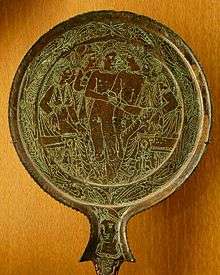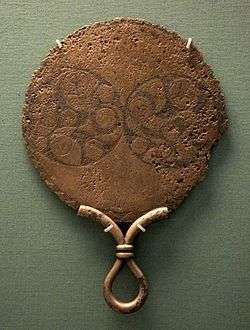Bronze mirror
Bronze mirrors preceded the glass mirrors of today. This type of mirror, often incorrectly termed a copper mirror, has been found by archaeologists among elite assemblages from various cultures, from Etruscan Italy to China.

History
_with_'TLV'_Design_LACMA_AC1998.251.29.jpg)
Indus valley civilization
In the Indus valley civilization, manufacture of bronze mirrors goes back to the time between 2800 and 2500 BCE.[2] Bronze mirror are usually circular.
Tamil Vaigai Civilization
With excavations in Adichanallur and Keeladi in Tamilnadu, India, it is confirmed that there lived communities around the Vaigai river valley. The excavations done in Adichanallur in 1899 by Alexander Rea, the then Superintendent of the Archeological Survey of India, Southern circle brought out two bronze circular items[3]. They are bronze mirros similar to ones found in other civilisations. Carbon dating of samples tested resulted in the age of such items to be before 1500BC [4].
China

Bronze mirrors were produced in China from neolithic times until the Qing Dynasty, when western glass mirrors were brought to China. Bronze mirrors were usually circular, with one side polished bright, to give a reflection, and the reverse side with designs. They often had a knob in the center so that they could be attached to clothing. Some of the earliest examples of Chinese bronze mirrors belonged to the Neolithic Qijia culture from around 2000 BCE. However, until Warring States times, bronze mirrors were not common with approximately only twenty having been discovered. During the Warring States period, mirrors became particularly popular. It was during the Han Dynasty, and the introduction of the TLV mirror, that mirrors started to be mass-produced. Both Han and Tang mirrors are considered to be the most technically advanced. Bronze mirrors continued to remain popular up through the Song Dynasty, but then gradually lost their popularity and ceased to be produced after the arrival of Western mirrors during the Ming and Qing dynasties.
Europe
In Europe, bronze mirrors from the Bronze Age and Iron Age have been discovered from various places, including Britain and Italy. Two notable examples include the Birdlip and Langton Herring mirrors.[5] Etruscan mirrors were produced from between the 6th and 2nd centuries BCE. Celtic mirrors in Britain were produced up until the Roman conquest.[6]
References
- Z. Y. Saad: The Excavations at Helwan. Art and Civilization in the First and Second Egyptian Dynasties, University of Oklahoma Press, Oklahoma 1969, p.54
- Richard Corson: Fashions in Makeup: From Ancient to Modern Times, 1972, ISBN 0-7206-0431-1, p.32
- Alexander Rea: Catalogue of the Prehistoric Antiquities,1915, Item 15,23, Plate II
- B SASISEKARAN et al: ADICHANALLUR: A PREHISTORIC MINING SITE, Indian Journal of History of Science, 45.3 (2010) 369-394
- Russell, M. (2019). "The girl with the chariot medallion: a well-furnished, Late Iron Age Durotrigian burial from Langton Herring, Dorset". Archaeological Journal. 176. doi:10.1080/00665983.2019.1573551.
- Lloyd-Morgan, Glenys (1977). 'Mirrors in Roman Britain', in J. Munby and M. Henig (eds), Roman Life and Art in Britain. BAR. pp. 231–52.
Further reading
- B. Schweig: “Mirrors”, Antiquity, Vol. 15 (1941), pp. 257–268
- Glenys Lloyd-Morgan 'Mirrors in Roman Britain', in J. Munby and M. Henig (eds), Roman Life and Art in Britain, BAR Brit Ser 41 (1977), 231-52
- Glenys Lloyd-Morgan 'The antecedents and development of the Roman hand mirror', in H. M. Blake, T. W. Potter and D. B. Whitehouse (eds), Papers in Italian Archaeology I: the Lancaster Seminar. Recent Research in Prehistoric, Classical and Medieval Archaeology, BAR Supplementary Series 41 (Oxford; 1978), 227-35.
- Glenys Lloyd-Morgan 'The Roman mirror and its origins', in N. T. de Grummond (ed.), A Guide to Etruscan Mirrors (Tallahassee, Florida; 1982), 39-48.
External links
| Wikimedia Commons has media related to Bronze mirrors. |